

| End-User Guide > Desktop and Ribbon Bar > Create |
The Create section of the Ribbon bar contains functionality that enables the ability to originate loan applications with or without account products, as well as originate account applications in Temenos Infinity.

 |
Check out the Creating a Loan Application with Account Products video tutorial for an overview of the application initialization process and the account product functionality in the New Application screen. |
The Create topic provides the following information and instructions to assist users with creating an application:
To originate an application, click  within the Ribbon Bar.
within the Ribbon Bar.
Upon selecting  , the New Application screen appears in a new window.
, the New Application screen appears in a new window.
The New Application screen provides users with the ability to enter the information required to initiate an application as well as start the application process. This screen can also be customized to include a detailed value statement that can be used as a sales tool when initiating a new application.
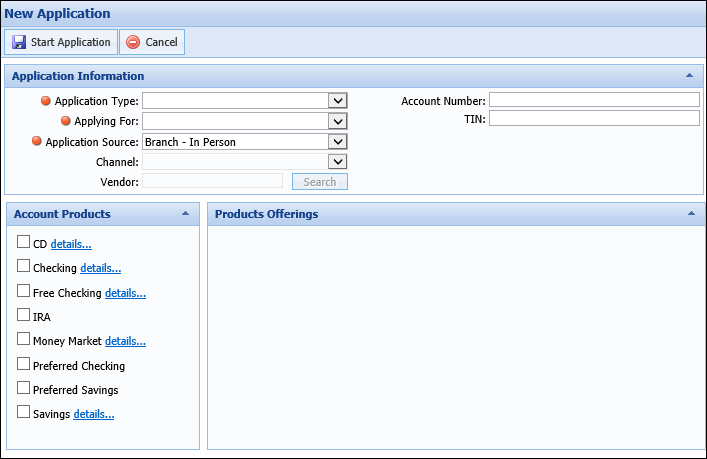
The New Application screen includes the following sections:
The Application Information section allows users to input the information required to initiate an application, such as the type of application being created, the product being applied for, the application source, channel, and/or vendor, as well as an account number or Taxpayer Identification Number (TIN) to identify the applicant.
The toolbar within the top of this section provides the ability to perform the following actions:
| Icon | Description | ||
 |
Allows a user to save the data entered in the Application Information section and create the application.
|
||
 |
Allows a user to cancel the application process. |
Reference the table below to assist with completing the fields within this section of the New Application screen:
| Field | Description | ||||||
| Application Type |
Select the type of application being created, either Loan or Account.
|
||||||
| Applying For |
Select the product for which the applicant is applying. This drop-down contains the active sub-products configured for the identified application type.
|
||||||
| Application Source | Use the drop-down to select how the application is being received. | ||||||
| Channel | Use the drop-down to select the Channel that is submitting the application. | ||||||
| Vendor |
Use the Search function to select the Vendor that is submitting the application.
|
||||||
| Account Number |
If the applicant is a current account holder, enter the account number to associate with the application.
|
||||||
| TIN |
If the applicant’s account number is unknown, or the applicant is not a current account holder, enter the applicant’s Tax Identification Number. This is also used for the Applicant’s Social Security Number (SSN).
As part of the application initialization process, the TIN is used to search the core and previous applications for information related to the applicant, and populates the following data in the application:
Demographics
Addresses
Assets
Liabilities
Core Messages Important core messages |
 |
At least one account product must be active in order for the Account Products section to appear within the New Application screen. For more information, please see the Account Products topic in the Administrator Guide. |
The Account Products section displays a list of the active account products configured by the system administrator in System Management > Origination > Account > Account Products.
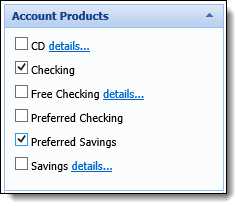
From this section of the New Application screen, users are provided with the ability to add an account product and view account product offerings.
To add an account product from the New Application screen, select the check box next to the desired account product(s).
 |
If configured by the system administrator, multiple account products of the same type can be added during the application process; however, only one of each account product type can be added to an application from the New Application screen. For more information, please see the Adding Account Products section of the Account Products topic in this guide. |
Once  is clicked, the selected account product(s) appear within the People, Products, and Collateral section in the Application Navigator.
is clicked, the selected account product(s) appear within the People, Products, and Collateral section in the Application Navigator.
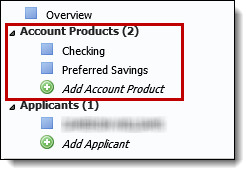
When configuring an account product, system administrators have the ability to customize a detailed value statement for each account product that can be used as a sales tool when initiating a new application.
 |
For more information on configuring a sales script for an account product, please see the Account Products topic in the Administrator Guide. |
If a sales script has been configured for an account product, a details... link appears next to the account product name as shown for Free Checking in the example below:
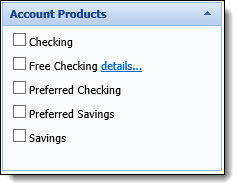
Click details... to view the sales script for the account product.
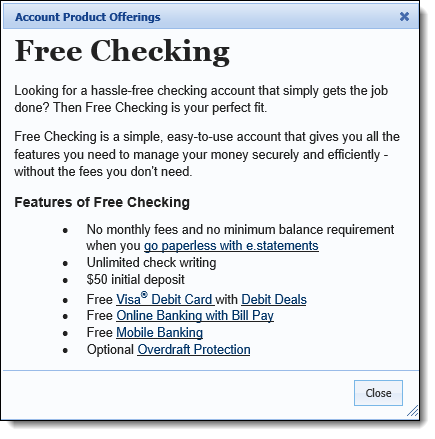
Upon selecting the sub-product being applied for, the Product Offering section populates with the customized Product Details and/or Sales Script configured by the system administrator in System Management > Origination >Loan > Loan Application Types or System Management > Origination >Account > Account Application Types. This section provides a detailed value statement about the selected product that can be used as a sales tool when initiating a new application.
 |
Information within the Product Offerings section may change based on the sub-product selected within the Applying For drop-down. |
Once all information within the New Application screen is complete, click  to create the application.
to create the application.
Upon clicking  , the system performs the Get Person/Get TIN process, which is comprised of the following steps:
, the system performs the Get Person/Get TIN process, which is comprised of the following steps:
Once the Get Person/Get TIN process completes, users are prompted to select the account from which data is retrieved within the Select Person to Create Application window if more than one record is returned by the system.
 |
If only one record is identified, the Select Person to Create Application window does not display to users. |
 |
For more information on the Select Person to Create Application window, please see the Applicants with Multiple Account Numbers section later in this topic. |
Once the person record has been identified, the associated TIN is used to identify existing applications and active offers. When there is one or more existing applications in progress or active offers, the Review Active Applications and/or Promotional Offers screen opens in a new window.
 |
For more information on the Review Active Applications and/or Promotional Offers screen, please see the Existing Applications and Active Offers sections later in this topic. |
When an application is being created for an existing account holder, once  is selected, the system performs an automatic search for the following information using the account number or TIN provided within the New Application screen:
is selected, the system performs an automatic search for the following information using the account number or TIN provided within the New Application screen:
When the account number or TIN provided for the applicant is associated with more than one record in the core, users are prompted to select the account from which data is retrieved within the Select Person to Create Application window.
 |
If contact with the core fails and the system fails to retrieve applicant information upon application initialization, an error message stating the exception details is displayed to the user. |
This window contains a list of all person records associated with the provided TIN or account number and enables the ability to select an applicant to assign to the application.
 |
When a TIN is entered to create the application, the system returns all records for the primary applicant that are related to the TIN. When an account number is entered to create the application, the system returns all records related to the account number, including those for Joint applicants related to the account. If a Joint record is selected, a message is received to inform that the application will be created as a non-member application. |
Highlight the desired record within the grid and click OK to proceed with the application process.
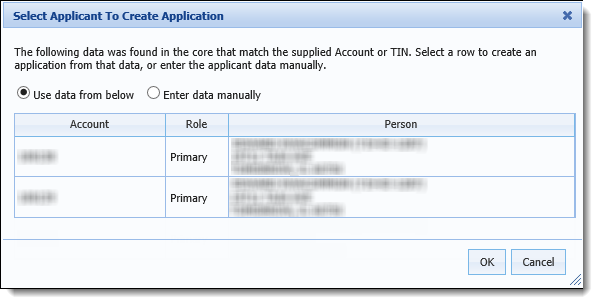
By default, the Use data from below radio button is selected, but the option to manually enter information for the applicant is available. If none of the records within the grid apply, select Enter data manually and click OK to manually enter information for the applicant.
 |
Upon selecting Enter Data Manually, the following information is pulled from prior applications in Temenos Infinity:
|
 |
When a record from the core is not selected, the sytem creates the application as a non-member application. For more information, please see the Create an Application for a Non-Account Holder section within this topic. |
 |
If an Indirect application is submitted for an applicant associated with a closed account, the following message appears: “The account and/or customer (<<AccountNumber>>) you entered has a status of closed. Would you like to create this application as a non-member?” If Yes is selected, the Account Number field is cleared and the user is taken to the Non-Member Create Application Screen. If No is selected, the message window closes and the user is returned to the previous window. |
Back to Create Application for Existing Account Holder ^
When the primary applicant exists as a joint/non-primary account holder within the core, users are prompted to select the account from which data is retrieved within the Select Person to Create Application window. This window contains a list of all person records associated with the provided TIN or account number and enables the ability to select an applicant to assign to the application.
 |
If a non-primary account holder is the primary applicant, the system creates the application as a non-member application. |
Highlight the desired record within the grid and click OK to proceed with the application process.
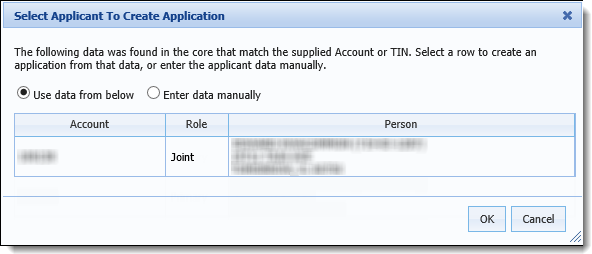
By default, the Use data from below radio button is selected, but the option to manually enter information for the applicant is available. If none of the records within the grid apply, select Enter data manually and click OK to manually enter information for the applicant.
Back to Create Application for Existing Account Holder ^
When there is one or more existing applications in progress, the Review Active Applications and/or Promotional Offers screen appears in a new window. This screen contains a list of in-progress applications associated with the applicant. In progress applications include all applications without a status of Withdrawn, Disbursed, Auto-withdrawn, LO Rejected, Invalid, Rejected, or Not Eligible.
 |
As shown in the below example, an Active Offers tab appears next to the Active Applications tab to list the promotional offers for which an applicant is eligible to apply. This tab appears within the screen regardless of whether the applicant is eligible for any promotional offers, but the grid within the Active Offers tab appears blank when the applicant is not associated with any active offers. For more information, please see the Active Offers section within this topic. |
By default, applications appear in the grid in a descending order with the most recently created application appearing at the top of the list. This list can be reorganized into ascending or descending order by clicking within the desired column and selecting the  that appears, as shown in the Application column in the below example.
that appears, as shown in the Application column in the below example.
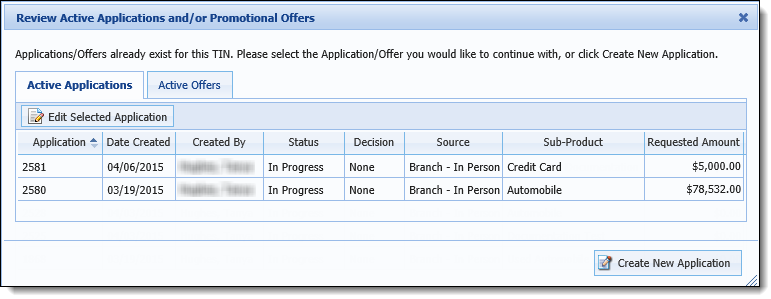
The grid within this screen displays the following columns of information for each active application:
| Column | Description |
| Application | Displays the Application number. |
| Date Created | Displays the date that the application was created. |
| Created By | Displays the name of the user who created the application. |
| Status | Displays the status of the application. |
| Decision | Displays the decision status of the application. |
| Source | Displays the source of the application. |
| Sub-Product | Displays the name of the application sub-product. |
| Requested Amount | Displays the Requested Amount for the application. |
To open an existing application, highlight the desired application within the grid and click  . The existing application opens and allows the user to continue processing the application.
. The existing application opens and allows the user to continue processing the application.
 |
When an existing application is loaded, the workspace automatically opens to the screen that was in progress when the application was last open. |
If none of the existing applications apply, select  to disregard all existing applications and create a new application.
to disregard all existing applications and create a new application.
Back to Create Application for Existing Account Holder ^
When an applicant is eligible for one or more promotional offers, the Review Active Applications and/or Promotional Offers screen appears in a new window. This screen contains an Active Offers tab that lists the active promotional offers associated with the applicant.
 |
If an applicant's TIN is related to more than one membership account in the core, and one or more of the accounts are closed, the system automatically creates the promotional offer for the first open account in the core. |
From this screen, users are able to create an application using data from a promotional offer.
 |
As shown in the below example, an Active Applications tab appears before the Active Offers tab to list any existing applications for an applicant. This tab appears within the screen regardless of whether the applicant is associated with any existing applications, but the grid within the Active Applications tab appears blank when the applicant does not have any additional active applications. For more information, please see the Existing Applications section within this topic. |
By default, offers are listed alphabetically by sub-product within the grid. This list can be reorganized into ascending or descending order by clicking within the desired column and selecting the  that appears, as shown in the Product/Sub-Product column in the below example.
that appears, as shown in the Product/Sub-Product column in the below example.
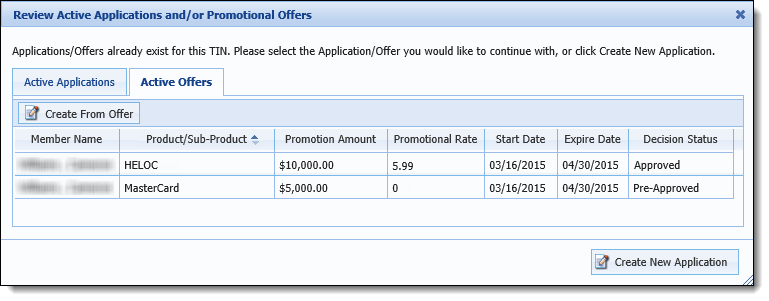
The grid within this screen displays the following columns of information for each active offer:
| Column | Description | ||
| Member Name | Displays the name of the applicant eligible for the offer. | ||
| Product/Sub-Product |
Displays the sub-product assigned to the promotional offer. When
|
||
| Promotion Amount | Displays the offer amount for which the customer is eligible to apply. | ||
| Promotional Rate | Displays the rate associated with the offer. | ||
| Start Date | Displays the start date of the promotion. | ||
| Expiration Date | Displays the expiration date of the promotion. | ||
| Decision Status |
Displays Pre-Approved or Approved to identify the Decision Status configured by the system administrator when the promotion was created. The value identified here determines the stage of the application initiated when an application is created from a promotion as well controls how Risk is processed for the application.
|
To create an application from a promotional offer, highlight the desired offer within the Active Offers grid and click  . Clicking
. Clicking  automatically initiates the application process, creating an application using the TIN associated with the offer and pre-populating all available information from the offer, such as applicant details, rate and term, within the application.
automatically initiates the application process, creating an application using the TIN associated with the offer and pre-populating all available information from the offer, such as applicant details, rate and term, within the application.
 |
When an application is created from a promotional offer, the Application > Channel field is set to a value of PROMOTION to identify the origin of the application.
Additionally, the availability of the Change Product button is determined by the number of application types assigned to the promotion by the system administrator.
|
 |
The following process walks through the behavior that occurs when a standard application is created from a promotional offer. For information on the process that occurs to create an indirect application from a promotional offer, please see the applicable third party connector guide on the Temenos Client Portal. Please see the Indirect Processing Overview topic in the Administrator Guide for information on the configurations required to link a promotional offer to an indirect application during the decision process. |
Depending on the Decision Status configured for the offer when the promotion is created, the application workspace automatically opens to the applicable stage in the workflow. For example, if the Decision Status for a promotion is Approved, when an offer is accepted, the application opens in the Approval stage of the workflow.
 |
When a promotion's Decision Status is configured as Approved, but the Loan Terms are not fulfilled, an error message including the necessary information is received during application initialization and the application opens in the Origination stage. For example, when the decision status for a Home Equity promotion is configured as Approved, the following error message is received to inform that balloon term is required:
|
When the decision status is Pre-approved, the application workspace opens in the Origination stage and users are able to proceed through each stage to complete the application process.
The Decision Status for a promotion also controls the Risk process. The Risk process proceeds as follows for each decision status:
| Decision Status | Risk Process |
| Approved | When a decision status is set to Approved, credit is NOT pulled for the applicant and the application process proceeds through the Approval stage of the application. |
| Pre-Approved | When a decision status is set to Pre-Approved, credit is pulled for the applicant and the application proceeds through each stage of the application. |
Back to Create Application for Existing Account Holder ^
When the primary applicant is a non-account holder and/or data cannot be located in the core for the supplied TIN, an application is created as a Non-Member application. Upon selecting  , the following window appears to enter information for the applicant:
, the following window appears to enter information for the applicant:
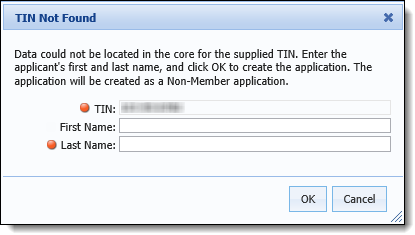
The TIN pre-populates with the number provided within the New Application screen. Enter the applicant's First Name and/or Last Name within the fields that display and click OK.
When the primary applicant is a non-account holder, but the supplied TIN is associated with a promotional offer, the Review Active Applications and/or Promotional Offers window appears upon selecting  . Within the Active Offers tab, select an offer and click
. Within the Active Offers tab, select an offer and click  to create a Non-Member application with pre-populated data from the promotional offer, including the applicant's TIN, First Name and Last Name.
to create a Non-Member application with pre-populated data from the promotional offer, including the applicant's TIN, First Name and Last Name.
 |
If the Eligibility Required parameter is set to Yes within the Origination page in System Management, the eligibility status must be set for the applicant in order for the application to be processed from the promotional offer successfully. |
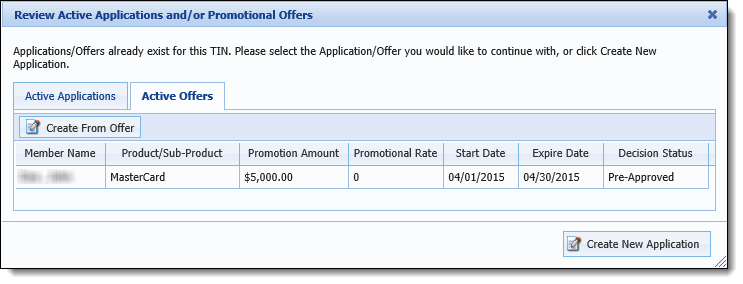
To disregard the offer and proceed with creating the Non-Member application, click  . When
. When  is selected, the Non-Account Holder process proceeds and the TIN Not Found window appears to enter the applicant's First and Last Name.
is selected, the Non-Account Holder process proceeds and the TIN Not Found window appears to enter the applicant's First and Last Name.
 |
For more information about adding a non-account holder to an application, please see the Applicants topic within this guide. |
If enabled within the Solutions.Origination page, Validation rules are processed against the criteria entered in the request.
TIN Validation Rules enable the system to efficiently handle invalid Tax Identification Numbers entered in the application request.
 |
Additional applicants added to an application are subject to TIN validation. |
If a TIN fails validation, the Is Invalid TIN field becomes selected and prior applications are not searched for applicant information with matching TINs.
 |
The Is Invalid TIN field is a read only field and cannot be manually cleared by a user. |
 Application Initialization Validation
Application Initialization Validation